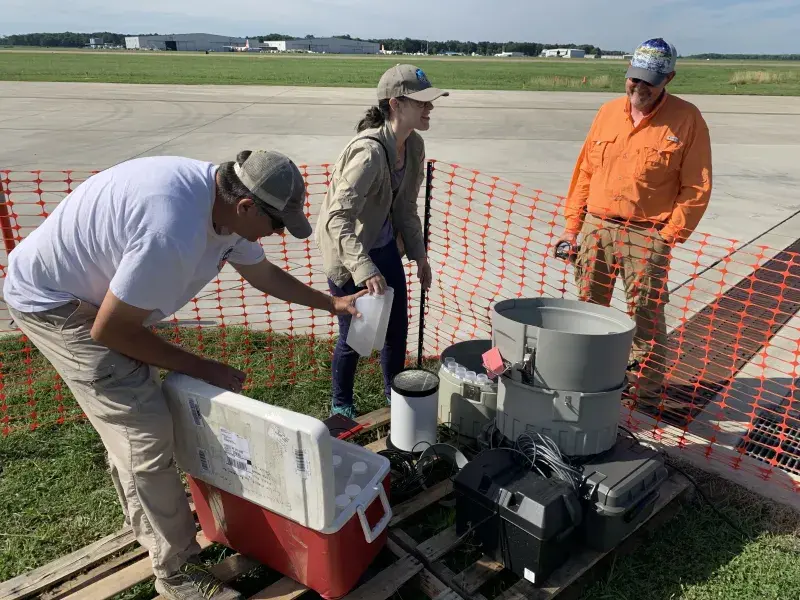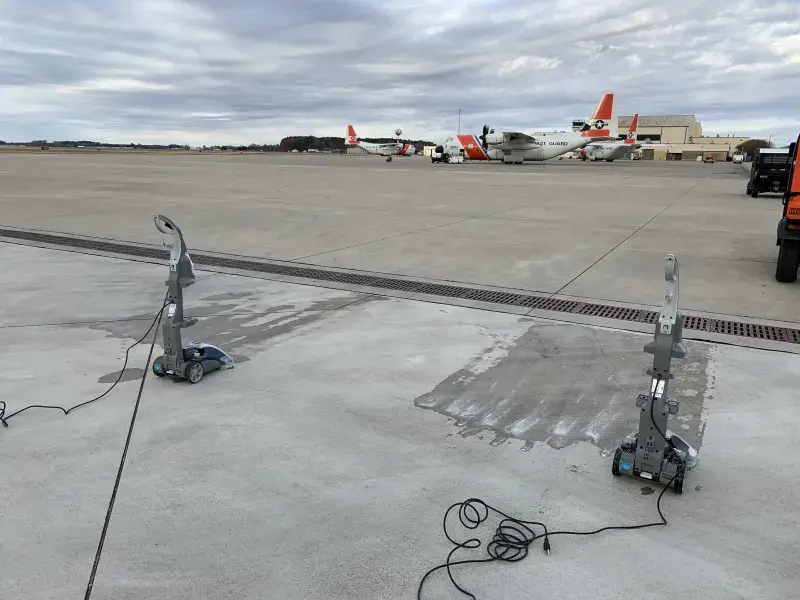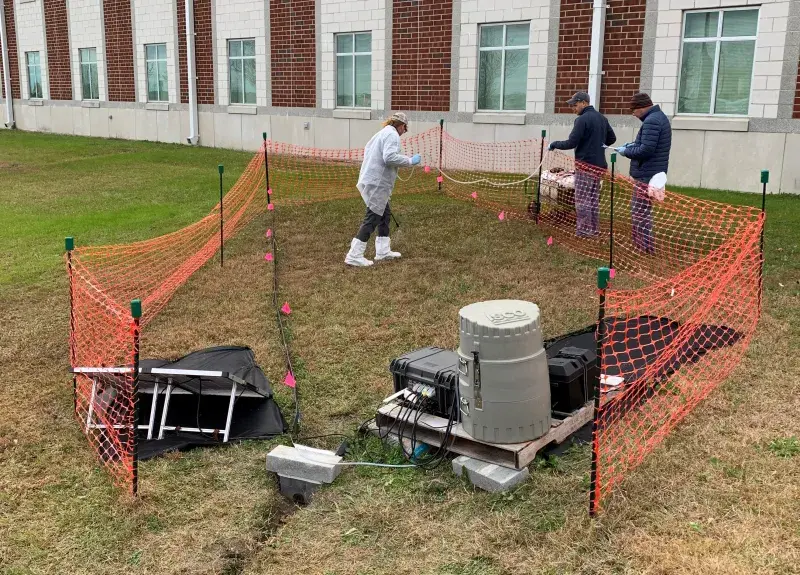If a large-scale contamination with a biological agent took place near a major coastal city, it would impact how the U.S. Coast Guard (USCG) carries out its lifesaving, environmental and interdiction missions—not to mention the toll on surrounding communities. To help the agency better prepare, respond, and recover, the Science and Technology Directorate (S&T) and the U.S. Environmental Protection Agency’s (EPA) Homeland Security Research Program joined forces for a Stormwater Tracer Study at Coast Guard Base Elizabeth City in North Carolina. The study tracks movement of ‘pathogen’ spores, which may be carried downstream by runoff after rainstorms, thereby complicating mitigation and decontamination measures. Through sampling and modeling, spores transported by stormwater runoff can be predicted and verified to assist in the effective cleanup of a site.
“The Stormwater Tracer Study helps us have a better understanding of how rain transports spores and enhances emergency response by increasing the effectiveness and timeliness of sampling and decontamination activities for the impacted stormwater,” said Dana Tulis, director of Emergency Management at USCG headquarters.
The study is part of a multi-year project called Analysis for Coastal Operational Resiliency (AnCOR), which kicked off in 2018 and included several joint field tests. Together, S&T, EPA and USCG have been working to identify the best and safest methods to decontaminate bases, stations and vessels, should they be affected by a large-scale contamination from a pathogen like the anthrax-causing bacterium.
The first major AnCOR field test took place in early 2020 at the University of Florida, during which the agencies decontaminated a Coast Guard boat ‘contaminated’ with non-pathogenic spores. In 2021, the team initiated the new Stormwater Tracer Study, which allowed them to gauge how rain transports the benign spores meant to simulate what would occur in the environment. Knowing in advance how pathogens may make their way towards USCG installations and surrounding communities allows responders to trace the spores more quickly after rainstorms and develop decontamination strategies.
“S&T funded the tracer studies to support EPA in building a general hydrodynamic model for USCG. The model will help select outdoor areas to sample for biological agents like Bacillus anthracis following rainfall events,” said Dr. Don Bansleben, S&T program manager for Chemical and Biological Detection. “Such information maximizes the probability of finding spores that may be transported or concentrated during a rainfall to determine if concrete, asphalt, and grassy areas continue to represent a threat to health.”
Identifying Solutions for a Quick Return to Normal after Pathogenic Contamination
When a surface is contaminated with anthrax-causing spores, rain can wash them off the initial site of contamination and transport them to stormwater systems through high-traffic urban areas, such as roadways and parks. This complicates cleanup and the return to normal operations.
“Capabilities and optimal methods for cleaning up the outdoor environment after a bioagent incident still require further research to fully assess their effectiveness, and human and environmental safety,” said Dr. Anne Mikelonis, an environmental engineer in EPA’s Homeland Security Research Program, who led the Stormwater Tracer Study.
The goal was to develop and assess hydrodynamic modeling tools to predict the movement of the bio-contaminant (spores) by rain in a wide-area environment in order to enhance response operations. For this purpose, EPA researched USCG stormwater systems to identify and summarize differences in meteorological and terrain features and operations. The research findings will help refine the parameters used in the hydrodynamic models to make more precise predictions. Additionally, researchers developed automated water samplers to remotely activate collection of stormwater runoff samples at different points throughout a rainstorm and analyze them for spore concentrations.
For the first phase of the study, the researchers visited Coast Guard Base Elizabeth City, North Carolina, in June 2021. There, they installed watershed monitoring sensors and stormwater runoff collection systems in four areas—concrete, asphalt, grass, as well as a control area collecting runoff from a parking lot not inoculated with spores.

In the photo above, Mikelonis arranged 1-liter bottles inside the autosampler, which collected runoff rainwater as instructed remotely via text messages (e.g., “take samples every 15 minutes”). One type of sensor used in this study was the soil moisture probes, which measured stormwater infiltration, a parameter useful for modeling how much rainfall turns into runoff versus being soaked up by the soil. The deployed rain gauges measured rain quantity via a mechanism called a tipping bucket, which resembles two small teaspoons joined at their bases. Raindrops are funneled and gradually fill one of the ‘buckets’ until it tips and touches a counting sensor that transmits the information to the researchers. Meanwhile, the other bucket is filling, and so on. The quantity of rain is calculated from the number of tips. A second type of rainfall sensor deployed in Elizabeth City is called a laser disdrometer. It measures raindrop size and velocity when rain droplets pass through the laser’s path. This allows researchers to characterize the kinetic energy of each rainfall.
The second phase of the study took place in late December 2021 and early January 2022. In a scenario where spores are released via aerosol across the entire base, researchers wanted to understand what the movement of those spores during a rainfall would look like after they have fallen to the ground over parking lots and other surfaces. To simulate this scenario, researchers used a rolling sprayer to spread the non-pathogenic spores in three areas—an asphalt parking lot, a concrete runway and a grassy area. Then they waited for rain to come.

It rained four times over the course of the study, and the researchers collected and analyzed samples from each rain event. According to preliminary results, spores could be traced at the asphalt and concrete areas after the first two periods of rain. After the third rain, the spores significantly decreased. The fourth rain was very large and washed off some additional spores, but measurable spores in the stormwater runoff were not detectable in most samples. The grassy area produced runoff samples only after the fourth rain, as soil tends to soak up the water when dry. No spores were detected in the control area.
After pausing the study during January and early February due to freezing temperatures, the team returned in mid-February 2022 to apply spores again to the same areas. Stormwater runoff samples were collected and analyzed from the first three rainfalls to expand the December 2021 spore washoff dataset.
Tracer Studies Will Help Develop Prediction Maps of Spore Spread
“If we understand how the rain washes the spores off asphalt, concrete and lawns, we can know what coefficients to use in this type of hydrodynamic model for other locations that have those surfaces too,” said Mikelonis. “And then when it rains after a contamination event, we can build a site-specific model and maps beforehand or shortly after an incident. Through the hydrodynamic model, we’ll be able to monitor and predict where the hot spots will be after rain.”
Such maps will guide responders who need to know where to take samples and decontaminate.

“The stormwater hydrodynamic modeling software tool we funded can support actions or natural processes that can lead to faster recovery of outdoor areas contaminated by a biological agent,” said Bansleben.
After the Stormwater Tracer Study, two additional AnCOR field events are planned for this year. The first, a demo in Georgia evaluating commercial and municipal equipment for their potential use following a biological contamination incident, took place in March. The second, a wide-scale demo in Virginia involving decontamination of various surfaces and boats, is planned for May. The full scope of this work will result in guidance for first responders on decontamination and recovery after biological events.
For more information, please contact S&T’s Chem-Bio Detection program at [email protected]




